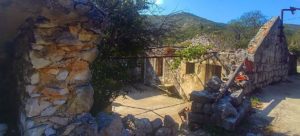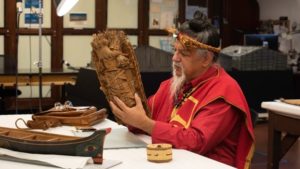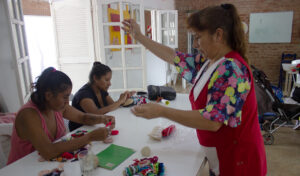Hundreds of volunteers, mainly young women, choose to perform vital research work at the memorial on the site of the former Nazi death camp. Haaretz joins some of them for a day
OSWIECIM, Poland – Tahel Goldsmith works in the darkest place in human history. As a volunteer.
For the past four months, the 33-year-old doctoral candidate at the University of Chicago has been working at the Auschwitz-Birkenau memorial and museum, spending her nights sleeping in the very room where the death camp’s commander, Rudolf Höss, allegedly oversaw the mass murder of some 1.1 million people (of whom 90 percent were Jews).
Few people outside the region or academic circles know that young volunteers work at this world-famous memorial in southern Poland. But 77 years after the liberation of Auschwitz, the importance of the volunteer program here is undiminished as a new generation reckons with how to handle the memory of the Holocaust.
There is a musty smell in the stairway of the building in which the overseas volunteers live and sleep. It’s an old brick building formerly used by the SS administration, right next to the camp’s fence. A cat scurries into the stairway, seeking shelter from the rain outside.
Suzanne Grimmer, also 33, a student from Louisiana State University, comes down the stairs dressed in black. As she steps outside and pulls her hood over her blond hair, one of the few splashes of color disappears from this gray morning scene.
Grimmer and Goldsmith are headed to Block 24, which nowadays houses the museum’s archives. The building was formerly used for the management of the camp, and prisoners had to help the SS administration with paperwork there.
En route to the archives, the two volunteers pass a low building whose chimney can also be seen from the kitchen window of their building: Crematorium I. Between late 1941 and December 1942, the SS sent prisoners here to be gassed and then cremated by fellow inmates. Later, the SS did its killing in Birkenau, 2 kilometers (just over 1 mile) away. In the crematoria II to V, up to 15,000 people were murdered daily. According to the records, up to 2,000 fit into each gas chamber.
The students reach a gate – probably the most infamous in the world – with the words “Arbeit macht frei” (“Work sets you free”) written in iron lettering.
The first brick building on the left is Block 24. In its hallway hang portraits of the living: a gallery of survivors. Each face drives home the failure of the Final Solution. Witnesses of the Holocaust leave a precious legacy, and people like Goldsmith and Grimmer aspire to carry on the tradition of the survivors.
At her workplace in the archive, Goldsmith dons gloves to protect the papers she is paging through. Today, she is studying the notes of the late Kazimierz Smole: He was a political prisoner in the camp himself and co-founded the memorial in 1947 (directing it for 35 years, from 1955 to 1990).
“Smole was very innovative,” Goldsmith says. He and others tracked down survivors and then recorded their memories. “This was early history writing from below, long before Yad Vashem started doing it,” she notes.
She has also visited concentration camp sites at Treblinka, Bergen-Belsen and Buchenwald for her dissertation on memory culture. It’s not an easy subject, she says. As for her current location, she calls Auschwitz “good for deeper thinking – but yes, it’s creepy. I spend the weekends in Krakow.”

A ‘productive place’
Goldsmith’s ancestors from her grandfather’s side hail from Poland. Her grandfather will soon be 101 and lives in Jerusalem. He was born in a town called Leajsk, some 40 kilometers away from Auschwitz. His family managed to stay together during the war, escaped to the Soviet Union, survived hunger and a labor camp there. After the war they emigrated to Paris and finally to Uruguay. In 1973, Goldsmith’s grandparents moved to Israel.
Some of her relatives did not find a way out of Eastern Europe and were killed in Treblinka. “In my family, the Holocaust was always an issue,” she says, “Starting when I was very little, my grandfather would sit me in front of him and tell me a story. He would always start with a quiz: ‘Do you remember what happened on September 1, 1939?’” But his stories were always fragmented. “My grandfather went in and out of mental hospitals his whole life, it’s a classic post-traumatic story,” she recounts. “He talked to me in a mixture of Yiddish and Spanish, told me anecdotes of the scariest things. But I didn’t get a coherent story.”
Perhaps this explains why Goldsmith finally became a historian, to try to assemble the fragments and gain a scientific view of the unexplainable. Like all of the volunteers she works at the memorial without payment, but receives a scholarship from her university. Her research profits from the access to local sources and immediate objects.
For her accommodation in the former SS building, Goldsmith pays 10 zlotys per night – the equivalent of $2.50. “For me, memorials are first and foremost productive places,” she says.
A master’s student in library science, Grimmer also aims to keep memories alive as she spends six weeks at the memorial. She points to a gray steel cabinet in the archive: “That’s our Google,” she quips.

The cabinet drawers contain tens of thousands of search requests: forms filled out by hand, documenting who contacted the memorial, and when, to find out about a relative.
She is helping build a database that makes the paths of suffering visible, charting the hundreds of thousands of inmates who left traces on transport lists and index cards. A scan of a pink document appears on Grimmer’s screen: Moses Honig, a tailor from Krakow who was sent to Auschwitz. He has even signed the document – presumably the last time he ever wrote his name.
“We have only 3,660 out of the 400,000 documents in our database; it’s going slowly,” Grimmer admits. When she returns to the United States, she will continue to work on the project from her home office.
Another volunteer, Paulina Byrska, sits in front of a scanner. The 20-year-old lives in Grzawa, a 30-minute drive away in Silesia. She is studying English and assists with translations. “I like to help because the work is important,” she says. “It’s hard to explain to people, but today this is a good place,” she adds.

Pilgrims, not tourists
Outside, visitors walk along the former death camp’s paths, which are wet this morning from the rain. Some seem reverent, some shocked, others stop to take photos in front of the gallows near the prisoners’ kitchen. (If any prisoners escaped, the SS had other prisoners hanged here as a deterrent.)
The sky has assumed the color of the concrete wall bordering the camp to the west. Behind it we find the building where the head of the volunteer program, Katarzyna Marcak, has her office.
“I never wanted to work here,” she says, candidly. Still, in 2012 she gave it a try – and has not regretted her decision.
Usually, over 500 volunteers work at the memorial every year, including two groups of 40 trainees from Volkswagen in Germany who attend for a couple of days biannually. (In 2021, the number of total volunteers dropped to 230 due to the pandemic.) For many, it’s a chance to gain experience abroad and extend their education. Most come from Poland and Germany, though, and 80 percent of them are women.

Marcak previously worked as a teacher and remains an educator at heart. She has photos of “her” volunteers on her desk, and says the experience of volunteering at Auschwitz changes them. For instance, normally shy people start speaking English to international visitors, while youngsters mature into compassionate adults.
Huge amounts of ash and other damning evidence are buried in the forest behind Birkenau’s old gas chambers, sometimes coming to the surface. In 1980, for example, a volunteer found the notes of a prisoner named Marcel Nadjari who had worked in a crematorium.
The eyewitness described what took place at the site and hid his report in a thermos bottle, but there are not enough words to comprehend the horror. Perhaps Marcak is right when she calls the people who come to the memorial site as neither visitors nor tourists. She speaks of pilgrims.
Sacred place
A while later, Layla Amador, 22, comes into the archive. We can’t speak in her actual workplace, the conservation department, because of coronavirus restrictions. She speaks softly, as if in a sacred place. She’s studying anthropology at the University of Utah, Salt Lake City, but defying the dulcet tones with which she speaks, she declares: “I don’t like the term neo-Nazis, because there’s nothing new about them – they’re Nazis.”

This is her last day at the memorial before she returns to the U.S. For the past two months, she has dedicated herself to shoes. People were ordered to remove their footwear before going to the gas chambers, and as a result there are more than 100,000 individual shoes here.
Amador’s job involved examining 35 pairs and treating them with preservatives. “I don’t want us to let nature take its course,” she explains. “When there are no more survivors, these artifacts will tell what happened.”
Sometimes her job has been heart-wrenching. In a shoe suitable for a 4-year-old girl, she discovered a dried-up small bean. She and Goldsmith learned that beans had been considered lucky charms in Hungary. A man’s shoe contained a newspaper report on a soccer game in Katowice. Money or a note turned up in others. Amador says she was most taken by a mismatched pair tied together: a woman’s shoe knotted to a child’s shoe, in a final gesture of love.
As it is her last day, Byrska, Goldsmith and Grimmer all come downstairs to say farewell. After they hug, Amador sets off to the bus stop. “I’m grateful that I was able to work here,” she says.

‘Memories have life cycles’
As evening falls, Goldsmith sits in a restaurant by the visitors’ parking lot. Behind her rests a vending machine that spits out souvenir coins with the Birkenau unloading ramp embossed on them. “I find it exciting how remembrance changes. Memories have life cycles,” she says.
The museum’s founders placed special emphasis on preserving objects in their 1945 condition. Sometimes, though, they preferred to rededicate – like with the old SS building that now houses the volunteers.
In Robert Menasse’s 2019 novel “The Capital,” the fictional Prof. Alois Erhart promotes rededication on a larger scale. He suggests that the European Union build a new capital, in a place that symbolizes both catastrophe and its overcoming. This capital, he says, should be located in Auschwitz. Nobody listens, of course – and Goldsmith also rejects the idea: “Too many tortured souls here.”
Heading back to her temporary home, she has to walk around half the camp as the visitors’ entrance has long since closed. On the way, lanterns cast cones of light into the darkness and the crematorium’s chimney looms in the mist. Despite such nightmarish vistas, Goldsmith is sure she will sleep well. The hell of the past can also provide hope for the future.
When Goldsmith and Grimmer head for work the next morning, the smell of coffee permeates the stairway. The cat scurrying around the stairwell belongs to Anna Odi, the daughter of a survivor. Her father had filled the old building with life after its liberation.
The two women pass the crematorium, which has become a place of contemplation for people of all faiths. More than 2 million visitors and tourists – the pilgrims – come here to reflect on being human, on hate and on exclusion.
Soon afterward, they reach the archive. Orange light illuminates the portrait photos in the hallway. They walk past the survivors’ faces and continue their work.
Niclas Mueller is a journalist from Munich and chairman of the nonprofit association “European Utopia e.V.” (www.european-utopia.org), which stands up against nationalism and promotes quality journalism across borders.




